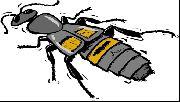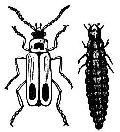Natural Solutions to Things That Bug You (78 page)
Read Natural Solutions to Things That Bug You Online
Authors: Myles Bader

GROUND BEETLES
General Information:
These night-hunting beetles can boast over 20,000 species worldwide and are rarely seen, making it hard to identify them. They are black and somewhat iridescent with bodies that are shaped like a shield.
They may go by the name
“caterpillar hunter.”
Their favorite foods include ants, cutworms, termites, spider mites, gypsy moths, mosquitoes, snails and slugs.
They may even be seen climbing a tree to get to their prey. Some of these beetles will expel a foul-smelling gas if you go to pick them up.
ROVE BEETLES
General Information:
 This beetle looks more like an earwig (without the pincers) than a true beetle. It tends to prefer scrounging around in decaying material looking for prey and is especially fond of cabbage beetles, mites, bark beetles and cabbage maggots.
This beetle looks more like an earwig (without the pincers) than a true beetle. It tends to prefer scrounging around in decaying material looking for prey and is especially fond of cabbage beetles, mites, bark beetles and cabbage maggots.
SOLDIER BEETLES
General Information:
 These beetles have a long rectangular body that is brownish in color. It looks like a firefly but without the taillight. The larvae enjoy feasting on many of the bad insects; however, the adults love an easy life of retirement and just hang around on a flower with their legs up taking it easy. The adult beetles will feed mainly on aphids and grow to about ½ inch in length.
These beetles have a long rectangular body that is brownish in color. It looks like a firefly but without the taillight. The larvae enjoy feasting on many of the bad insects; however, the adults love an easy life of retirement and just hang around on a flower with their legs up taking it easy. The adult beetles will feed mainly on aphids and grow to about ½ inch in length.
TIGER BEETLES
General Information:
 These are the professional hunter beetles that are a pretty iridescent blue, green and bronze.
These are the professional hunter beetles that are a pretty iridescent blue, green and bronze.
They are speedy, large beetles that can grow to ¾ of an inch long. It prefers aphids and caterpillars but will not turn down other pests if they are readily available. This species is only found in the western United States. They usually lie in wait at the bottom of tunnels and wait for an insect to fall in for dinner.

CENTIPEDES
General Information:
 These creepy crawlers can actually have as many as 346 legs and sometimes as few as 30, which will depend on the species. They have a pair of claws that are venomous and can paralyze their victims. These are good to have around the garden since they eat snails, slugs, grasshoppers and many other pests. When you find them in the basement or house they are looking for cockroaches, flies and moths.
These creepy crawlers can actually have as many as 346 legs and sometimes as few as 30, which will depend on the species. They have a pair of claws that are venomous and can paralyze their victims. These are good to have around the garden since they eat snails, slugs, grasshoppers and many other pests. When you find them in the basement or house they are looking for cockroaches, flies and moths.

The very small centipede-looking bug, that you may see in your garden resembles a white centipede but are really “symphylan.” These can do a great deal of damage to plants and are mainly found in greenhouses in the southwestern states.
COUNT THEIR LEGS
 Centipedes are good for the garden and consume many of the garden pests; however, millipedes are not very good to have around.
Centipedes are good for the garden and consume many of the garden pests; however, millipedes are not very good to have around.
Millipede

MILLIPEDE TRAPPER
Find a tall can of any type, preferably one like a large tomato juice can and punch holes in both sides as well as the bottom of the can. Fill the can with some carrot and potato peelings. Once a week check the can and empty the millipedes into a bucket of soapy water then reset the trap.

DAMSEL BUG
Identification:
 These bugs are only about ¼ quarter inch long and have a body that narrows toward the head and have large front legs for grabbing small prey. They eat aphids, leafhoppers, treehoppers, psyllids, mites and small green caterpillars.
These bugs are only about ¼ quarter inch long and have a body that narrows toward the head and have large front legs for grabbing small prey. They eat aphids, leafhoppers, treehoppers, psyllids, mites and small green caterpillars.
